

Compact Muon Solenoid
LHC, CERN
| CMS-PAS-BPH-21-003 | ||
| Observation of new structures in the J/$\psi$J/$\psi$ mass spectrum in pp collisions at $\sqrt{s} = $ 13 TeV | ||
| CMS Collaboration | ||
| July 2022 | ||
| Abstract: A search is reported for low-mass structures in the J/$\psi$J/$\psi$ mass spectrum produced by proton-proton collisions at $\sqrt{s} = $ 13 TeV. The data sample corresponds to an integrated luminosity of 135 fb$^{-1}$ collected by the CMS experiment at the LHC. Modelling signals with relativistic Breit-Wigner shapes, and under the assumption of the absence of interference between signal components, and between signal and background, three structures are identified. Two structures are observed with local significances well above 5 standard deviations at masses of 6927 $\pm$ 9 (stat) $\pm$ 5 (syst) MeV and 6552 $\pm$ 10 (stat) $\pm$ 12 (syst) MeV. The first one is consistent with the previously observed X(6900). Evidence for a third structure is found at a mass of 7287 $\pm$ 19 (stat) $\pm$ 5 (syst) MeV with a local significance of 4.1 standard deviations. | ||
|
Links:
CDS record (PDF) ;
Physics Briefing ;
CADI line (restricted) ;
These preliminary results are superseded in this paper, Accepted by PRL. The superseded preliminary plots can be found here. |
||
| Figures & Tables | Summary | Additional Figures & Tables | References | CMS Publications |
|---|
| Figures | |
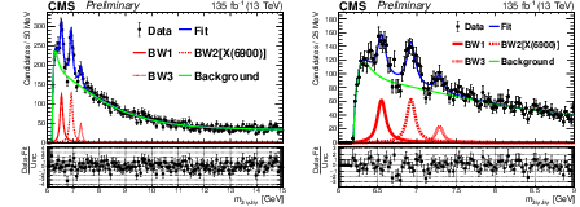
png pdf |
Figure 1:
The CMS J/$\psi$J/$\psi$ mass spectrum with a fit consisting of three signal BW functions and a background model (described in the text). The left plot shows the fit over the full mass range, and on the right is the same fit expanded by only displaying masses below 9 GeV. The lower portion of the plots shows the "pull quantities,'' i.e. the number of standard deviations that the binned data differs from the fit. |
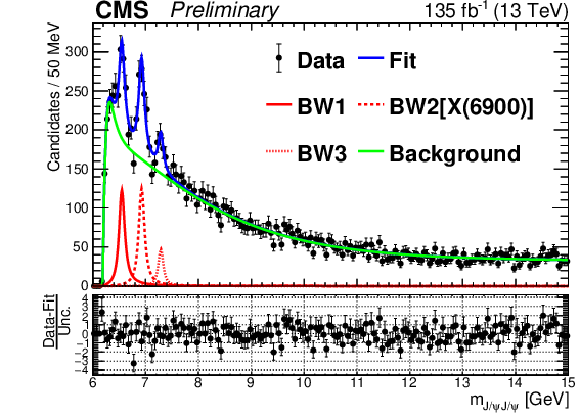
png pdf |
Figure 1-a:
The CMS J/$\psi$J/$\psi$ mass spectrum with a fit consisting of three signal BW functions and a background model (described in the text). The plot shows the fit over the full mass range. The lower portion of the plot shows the "pull quantities,'' i.e. the number of standard deviations that the binned data differs from the fit. |
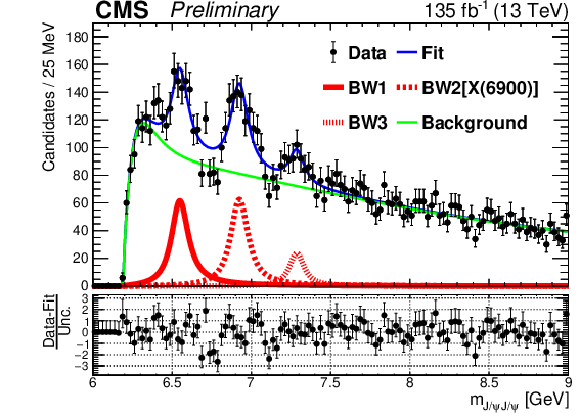
png pdf |
Figure 1-b:
The CMS J/$\psi$J/$\psi$ mass spectrum with a fit consisting of three signal BW functions and a background model (described in the text). The plot shows the fit over the full mass rang, only displaying masses below 9 GeV. The lower portion of the plot shows the "pull quantities,'' i.e. the number of standard deviations that the binned data differs from the fit. |
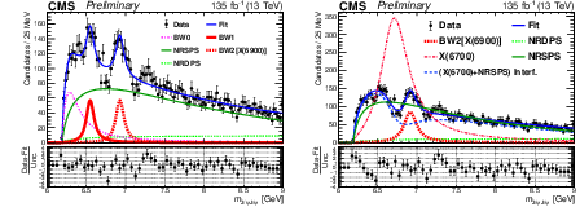
png pdf |
Figure 2:
The J/$\psi$J/$\psi$ mass spectrum after the final selection. The data are fit using LHCb models [15]: Model I (non-interference) on the left and Model II (interference) on the right (see text for model details). |

png pdf |
Figure 2-a:
The J/$\psi$J/$\psi$ mass spectrum after the final selection. The data are fit using LHCb Model I (non-interference) [15] (see text for model details). |

png pdf |
Figure 2-b:
The J/$\psi$J/$\psi$ mass spectrum after the final selection. The data are fit using LHCb Model II (interference) [15] (see text for model details). |
| Tables | |

png pdf |
Table 1:
Summary of the fit results of the CMS J/$\psi$J/$\psi$ distribution: the mass $m$ and natural width $\Gamma $, in MeV, and the signal yields $N$ are given for the three signal structures. The systematic uncertainties are discussed in Sec. 5. |

png pdf |
Table 2:
Systematic uncertainties on masses and widths, in MeV. |

png pdf |
Table 3:
Summary of results for the two LHCb fit models for LHCb and CMS: the mass $m$ and natural width $\Gamma $, in MeV, are given for the principal structures (the BW at threshold in Model I is not included), and LHCb values not reported in Ref. [15] are marked as `unrep.' Single uncertainties are statistical only. |
| Summary |
| In summary, the J/$\psi$J/$\psi$ mass spectrum from 135 fb$^{-1}$ of pp collisions recorded with the CMS detector has been presented. Observation of the X(6900) structure is confirmed, and two new ones, X(6600) and X(7300), are reported with respective masses 6552 $\pm$ 10 (stat) $\pm$ 12 (syst) MeV and 7287 $\pm$ 19 (stat) $\pm$ 5 (syst) MeV. The local (statistical) significance of these peaks, determined by the log-likelihood difference between the full non-interference fit and the version where a given Breit-Wigner lineshape is removed, are, for increasing mass, 6.5, 9.4, and 4.1 standard deviations. The resonance parameters of these states can be modified by interference--whose relevance is currently an open question--and this ambiguity motivates labeling these states with only rough mass values at this time. |
| Additional Figures | |
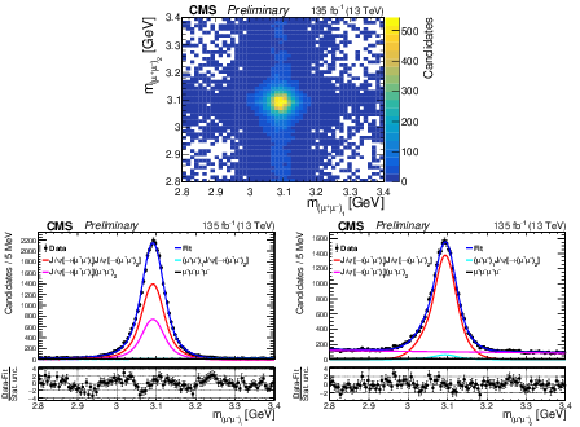
png pdf |
Additional Figure 1:
The dimuon-dimuon mass distribution after the final selection ($ \mathrm{J}/\psi\mathrm{J}/\psi $ mass window requirement and mass constraint excluded), with the $ (\mu^{+}\mu^{-})_1 $ pair being the higher $ p_{\mathrm{T}} $ pair (top). The horizontal [$ m_{(\mu^{+}\mu^{-})_1} $] and vertical [$ m_{(\mu^{+}\mu^{-})_2} $] projections are respectively shown in bottom left figure and bottom right figure, which include the results of a fit of the 2D distribution for the various signal and background components. |

png pdf |
Additional Figure 1-a:
Horizontal [$ m_{(\mu^{+}\mu^{-})_1} $] projection, which includes the results of a fit of the 2D distribution for the various signal and background components. |
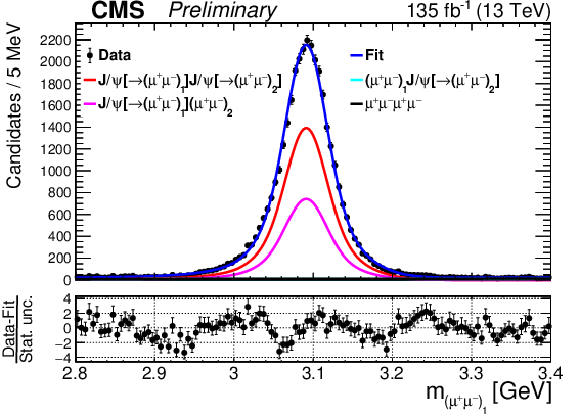
png pdf |
Additional Figure 1-b:
Vertical [$ m_{(\mu^{+}\mu^{-})_2} $] projection, which includes the results of a fit of the 2D distribution for the various signal and background components. |
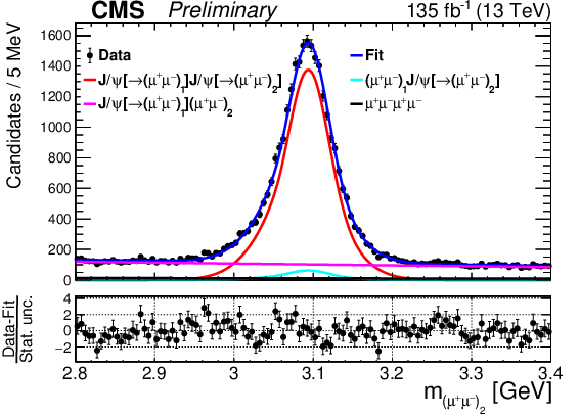
png pdf |
Additional Figure 1-c:
The dimuon-dimuon mass distribution after the final selection ($ \mathrm{J}/\psi\mathrm{J}/\psi $ mass window requirement and mass constraint excluded), with the $ (\mu^{+}\mu^{-})_1 $ pair being the higher $ p_{\mathrm{T}} $ pair (top). The horizontal [$ m_{(\mu^{+}\mu^{-})_1} $] and vertical [$ m_{(\mu^{+}\mu^{-})_2} $] projections are respectively shown in bottom left figure and bottom right figure, which include the results of a fit of the 2D distribution for the various signal and background components. |

png pdf |
Additional Figure 2:
The $ \mathrm{J}/\psi \mathrm{J}/\psi $ mass spectrum with a fit consisting of three signal BW functions and background composed of NRSPS and NRDPS components, and a threshold enhancement, BW0. Left figure shows the fit over the full mass range, and right figure is the same fit expanded by only displaying masses below 9 GeV. |
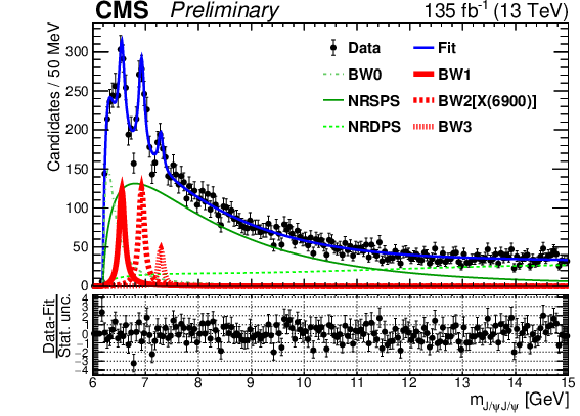
png pdf |
Additional Figure 2-a:
The $ \mathrm{J}/\psi \mathrm{J}/\psi $ mass spectrum with a fit consisting of three signal BW functions and background composed of NRSPS and NRDPS components, and a threshold enhancement, BW0. Fit over the full mass range. |
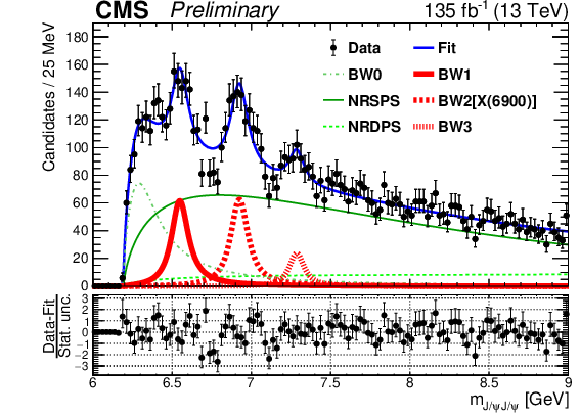
png pdf |
Additional Figure 2-b:
The $ \mathrm{J}/\psi \mathrm{J}/\psi $ mass spectrum with a fit consisting of three signal BW functions and background composed of NRSPS and NRDPS components, and a threshold enhancement, BW0. Same fit expanded by only displaying masses below 9 GeV. |
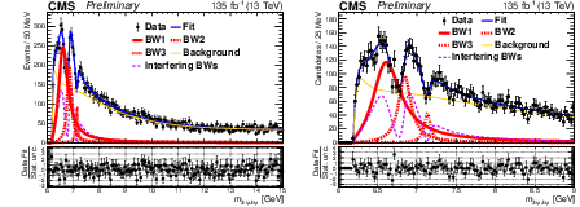
png pdf |
Additional Figure 3:
The $ \mathrm{J}/\psi \mathrm{J}/\psi $ mass spectrum with a fit consisting of three interfering signal BW functions and non-interfering background, composed of NRSPS and NRDPS components, and a threshold enhancement. The dashed ``interfering BWs" line refers to $ |r_1\exp(i\phi_1)\text{BW}_1+\text{BW}_2+r_3\exp(i\phi_3)\text{BW}_3|^2 $, where $ r_{1,3} $ and $ \phi_{1,3} $ are the relative magnitude and phase of $ \text{BW}_{1,3} $, with respect to $ \text{BW}_2 $. The three $ \text{BW}_{i} $ curves shown correspond to the squares of the BWs weighted to the squares of the corresponding coefficients in the amplitude. The continuous ``Background" line refers to the sum of the three background components. Left figure shows the fit over the full mass range, and right figure is the same fit expanded by only displaying masses below 9 GeV. |

png pdf |
Additional Figure 3-a:
The $ \mathrm{J}/\psi \mathrm{J}/\psi $ mass spectrum with a fit consisting of three interfering signal BW functions and non-interfering background, composed of NRSPS and NRDPS components, and a threshold enhancement. The dashed ``interfering BWs" line refers to $ |r_1\exp(i\phi_1)\text{BW}_1+\text{BW}_2+r_3\exp(i\phi_3)\text{BW}_3|^2 $, where $ r_{1,3} $ and $ \phi_{1,3} $ are the relative magnitude and phase of $ \text{BW}_{1,3} $, with respect to $ \text{BW}_2 $. The three $ \text{BW}_{i} $ curves shown correspond to the squares of the BWs weighted to the squares of the corresponding coefficients in the amplitude. The continuous ``Background" line refers to the sum of the three background components. Fit over the full mass range. |

png pdf |
Additional Figure 3-b:
The $ \mathrm{J}/\psi \mathrm{J}/\psi $ mass spectrum with a fit consisting of three interfering signal BW functions and non-interfering background, composed of NRSPS and NRDPS components, and a threshold enhancement. The dashed ``interfering BWs" line refers to $ |r_1\exp(i\phi_1)\text{BW}_1+\text{BW}_2+r_3\exp(i\phi_3)\text{BW}_3|^2 $, where $ r_{1,3} $ and $ \phi_{1,3} $ are the relative magnitude and phase of $ \text{BW}_{1,3} $, with respect to $ \text{BW}_2 $. The three $ \text{BW}_{i} $ curves shown correspond to the squares of the BWs weighted to the squares of the corresponding coefficients in the amplitude. The continuous ``Background" line refers to the sum of the three background components. Same fit expanded by only displaying masses below 9 GeV. |
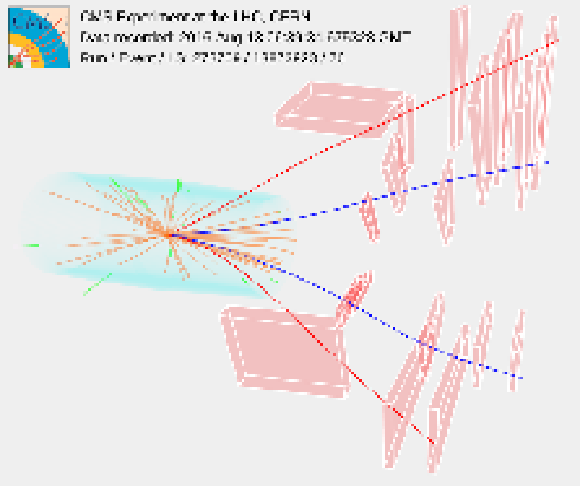
png pdf |
Additional Figure 4:
Event display showing a candidate for a X(6600) state decaying to a pair of $ \mathrm{J}/\psi $ mesons, followed by the decays of each $ \mathrm{J}/\psi $ to two muons. The mass of the muon pair represented by the red lines (blue lines) is 3.12 GeV (3.05 GeV) and the mass of the double-$ \mathrm{J}/\psi $ candidate is 6.52 GeV. |
| Additional Tables | |

png pdf |
Additional Table 1:
The fit results of the interference model for the CMS $ \mathrm{J}/\psi \mathrm{J}/\psi $ distribution: the mass $ m $ and natural width $ \Gamma $, in MeV, are given for the three signal structures. |

png pdf |
Additional Table 2:
Dominant contributions to the systematic uncertainties on masses and widths, in MeV, for the fit accounting for interference between the three resonances. The full uncertainty includes contributions from non-dominant uncertainties not listed here, and is a sum of individual components in quadrature. |
| References | ||||
| 1 | M. Gell-Mann | A schematic model of baryons and mesons | PL8 (1964) 214 | |
| 2 | Belle Collaboration | Observation of a narrow charmoniumlike state in exclusive $ \mathrm{B^{\pm}} \to \mathrm{K^{\pm}} \pi^{+} \pi^{-} \mathrm{J}/\psi $ decays | PRL 91 (2003) 262001 | hep-ex/0309032 |
| 3 | N. Brambilla et al. | The $ XYZ $ states: experimental and theoretical status and perspectives | PR 873 (2020) 1 | 1907.07583 |
| 4 | M. Nielsen et al. | Supersymmetry in the Double-Heavy Hadronic Spectrum | PRD 98 (2018) 034002 | 1805.11567 |
| 5 | M. Nielsen and S. J. Brodsky | Hadronic superpartners from a superconformal and supersymmetric algebra | PRD 97 (2018) 114001 | 1802.09652 |
| 6 | A. Ali, L. Maiani, and A. D. Polosa | Multiquark Hadrons | Cambridge University Press, Cambridge | |
| 7 | E598 Collaboration | Experimental observation of a heavy particle J | PRL 33 (1974) 1404 | |
| 8 | Mark I Collaboration | Discovery of a narrow resonance in e^{+}e^{-} annihilation | PRL 33 (1974) 1406 | |
| 9 | CDF Collaboration | Evidence for a narrow near-threshold structure in the $ \mathrm{J}/\psi\phi $ mass spectrum in $ \mathrm{B^{+}} \to \mathrm{J}/\psi\phi \mathrm{K^{+}} $ decays | PRL 102 (2009) 242002 | 0903.2229 |
| 10 | CDF Collaboration | Observation of the $ Y(4140) $ structure in the $ \mathrm{J}/\psi\phi $ mass spectrum in $ \mathrm{B^{\pm}}\to \mathrm{J}/\psi\phi \mathrm{K^{\pm}} $ decays | MPLA 32 (2017) 1750139 | 1101.6058 |
| 11 | CMS Collaboration | Observation of a peaking structure in the $ \mathrm{J}/\psi \phi $ mass spectrum from $ \mathrm{B^{\pm}} \to \mathrm{J}/\psi \phi \mathrm{K^{\pm}} $ decays | PLB 734 (2014) 261 | CMS-BPH-11-026 1309.6920 |
| 12 | LHCb Collaboration | Search for beautiful tetraquarks in the $ \Upsilon\text{(1S)}\mu^{+}\mu^{-} $ invariant-mass spectrum | JHEP 10 (2018) 086 | 1806.09707 |
| 13 | CMS Collaboration | Measurement of the $ \Upsilon\text{(1S)} $ pair production cross section and search for resonances decaying to $ \Upsilon\text{(1S)}\mu^{+}\mu^{-} $ in proton-proton collisions at $ \sqrt{s} = $ 13 TeV | PLB 808 (2020) 135578 | CMS-BPH-18-002 2002.06393 |
| 14 | ANDY Collaboration | Observation of Feynman scaling violations and evidence for a new resonance at RHIC | Submitted to PLB | 1909.03124 |
| 15 | LHCb Collaboration | Observation of structure in the $ \mathrm{J}/\psi $-pair mass spectrum | Sci. Bull. 65 (2020) 1983 | 2006.16957 |
| 16 | J.-Z. Wang, D.-Y. Chen, X. Liu, and T. Matsuki | Producing fully charm structures in the $ \mathrm{J}/\psi $-pair invariant mass spectrum | PRD 103 (2021) 071503 | 2008.07430 |
| 17 | A. V. Berezhnoy, A. V. Luchinsky, and A. A. Novoselov | Heavy tetraquarks production at the LHC | PRD 86 (2012) 034004 | 1111.1867 |
| 18 | J. Wu et al. | Heavy-flavored tetraquark states with the $ \mathrm{Q}\mathrm{Q}\overline{\mathrm{Q}}\overline{\mathrm{Q}} $ configuration | PRD 97 (2018) 094015 | 1605.01134 |
| 19 | H.-X. Chen, W. Chen, X. Liu, and S.-L. Zhu | Strong decays of fully-charm tetraquarks into di-charmonia | Sci. Bull. 65 (2020) 1994 | 2006.16027 |
| 20 | Y. Bai, S. Lu, and J. Osborne | Beauty-full tetraquarks | PLB 798 (2019) 134930 | 1612.00012 |
| 21 | Z.-G. Wang | Analysis of the $ \mathrm{Q}\mathrm{Q}\overline{\mathrm{Q}}\overline{\mathrm{Q}} $ tetraquark states with QCD sum rules | EPJC 77 (2017) 432 | 1701.04285 |
| 22 | M. N. Anwar et al. | Spectroscopy and decays of the fully-heavy tetraquarks | EPJC 78 (2018) 647 | 1710.02540 |
| 23 | J.-M. Richard, A. Valcarce, and J. Vijande | String dynamics and metastability of all-heavy tetraquarks | PRD 95 (2017) 054019 | 1703.00783 |
| 24 | A. Esposito and A. D. Polosa | A $ \mathrm{b}\mathrm{b} \mathrm{\bar{b}}\mathrm{\bar{b}} $ di-bottomonium at the LHC? | EPJC 78 (2018) 782 | 1807.06040 |
| 25 | M. Karliner, S. Nussinov, and J. L. Rosner | $ \mathrm{Q}\mathrm{Q}\overline{\mathrm{Q}}\overline{\mathrm{Q}} $ states: Masses, production, and decays | PRD 95 (2017) 034011 | 1611.00348 |
| 26 | M. A. Bedolla, J. Ferretti, C. D. Roberts, and E. Santopinto | Spectrum of fully-heavy tetraquarks from a diquark+antidiquark perspective | EPJC 80 (2020) 1004 | 1911.00960 |
| 27 | G. Yang, J. Ping, L. He, and Q. Wang | Potential model prediction of fully-heavy tetraquarks $ QQ\bar{Q}\bar{Q} $ ($ Q=$ c, b) | 2006.13756 | |
| 28 | X. Jin, Y. Xue, H. Huang, and J. Ping | Full-heavy tetraquarks in constituent quark models | EPJC 80 (2020) 1083 | 2006.13745 |
| 29 | M.-S. Liu, Q.-F. Lu, X.-H. Zhong, and Q. Zhao | All-heavy tetraquarks | PRD 100 (2019) 016006 | 1901.02564 |
| 30 | M.-S. liu, F.-X. Liu, X.-H. Zhong, and Q. Zhao | Full-heavy tetraquark states and their evidences in the LHCb di-$ J/\psi $ spectrum | 2006.11952 | |
| 31 | F.-X. Liu, M.-S. Liu, X.-H. Zhong, and Q. Zhao | Higher mass spectra of the fully-charmed and fully-bottom tetraquarks | PRD 104 (2021) 116029 | 2110.09052 |
| 32 | W. Chen et al. | Hunting for exotic doubly hidden-charm/bottom tetraquark states | PLB 773 (2017) 247 | 1605.01647 |
| 33 | G.-J. Wang, L. Meng, and S.-L. Zhu | Spectrum of the fully-heavy tetraquark state $ QQ\bar Q' \bar Q' $ | PRD 100 (2019) 096013 | 1907.05177 |
| 34 | R. Zhu | Fully-heavy tetraquark spectra and production at hadron colliders | NPB 966 (2021) 115393 | 2010.09082 |
| 35 | Y. Iwasaki | Is a state $ \mathrm{c}\mathrm{\bar{c}}\mathrm{c}\mathrm{\bar{c}} $ found at 6.0$ GeV? $ | PRL 36 (1976) 1266 | |
| 36 | K.-T. Chao | The ($ \mathrm{c}\mathrm{c} $) -- ($ \mathrm{\bar{c}}\mathrm{\bar{c}} $) (diquark-antidiquark) states in e^{+}e^{-} annihilation | Z. Phys. C 7 (1981) 317 | |
| 37 | C. Gong et al. | Nature of X(6900) and its production mechanism at LHCb | PLB 824 (2022) 136794 | 2011.11374 |
| 38 | B.-D. Wan and C.-F. Qiao | Gluonic tetracharm configuration of $ \mathrm{X}P{6900} $ | PLB 817 (2021) 136339 | 2012.00454 |
| 39 | J.-Z. Wang, X. Liu, and T. Matsuki | Fully-heavy structures in the invariant mass spectrum of $ \mathrm{J}/\psi \psi(3686) $, $ \mathrm{J}/\psi \psi(3770) $, $ \psi(3686)\psi(3686) $, and $ \mathrm{J}/\psi \Upsilon\text{(1S)} $ at hadron colliders | PLB 816 (2021) 136209 | 2012.03281 |
| 40 | CMS Collaboration | Precision luminosity measurement in proton-proton collisions at $ \sqrt{s} = $ 13 TeV in 2015 and 2016 at CMS | EPJC 81 (2021) 800 | CMS-LUM-17-003 2104.01927 |
| 41 | CMS Collaboration | CMS luminosity measurement for the 2017 data-taking period at $ \sqrt{s} = $ 13 TeV | CMS-PAS-LUM-17-004 | CMS-PAS-LUM-17-004 |
| 42 | CMS Collaboration | CMS luminosity measurement for the 2018 data-taking period at $ \sqrt{s} = $ 13 TeV | ||
| 43 | CMS Collaboration | The CMS experiment at the CERN LHC | JINST 3 (2008) S08004 | CMS-00-001 |
| 44 | CMS Collaboration | The CMS trigger system | JINST 12 (2017) P01020 | CMS-TRG-12-001 1609.02366 |
| 45 | T. Sjostrand, S. Mrenna, and P. Skands | A brief introduction to PYTHIA 8.1 | CPC 178 (2008) 852 | 0710.3820 |
| 46 | Y. Gao et al. | Spin determination of single-produced resonances at hadron colliders | PRD 81 (2010) 075022 | 1001.3396 |
| 47 | A. V. Gritsan et al. | New features in the JHU generator framework: Constraining Higgs boson properties from on-shell and off-shell production | PRD 102 (2020) 056022 | 2002.09888 |
| 48 | H.-S. Shao | HELACONIA: An automatic matrix element generator for heavy quarkonium physics | CPC 184 (2013) 2562 | 1212.5293 |
| 49 | J.-P. Lansberg and H.-S. Shao | $ \mathrm{J}/\psi $-pair production at large momenta: Indications for double parton scatterings and large $ {\alpha_S}^5 $ contributions | PLB 751 (2015) 479 | 1410.8822 |
| 50 | J.-P. Lansberg and H.-S. Shao | Production of $ \mathrm{J}/\psi+\eta_{c} $ versus $ \mathrm{J}/\psi+\mathrm{J}/\psi $ at the LHC: Importance of real $ {\alpha_S}^5 $ corrections | PRL 111 (2013) 122001 | 1308.0474 |
| 51 | H.-S. Shao | HELACONIA 2.0: An upgraded matrix-element and event generator for heavy quarkonium physics | CPC 198 (2016) 238 | 1507.03435 |
| 52 | H. Jung et al. | The CCFM Monte Carlo generator CASCADE version 2.2.03 | EPJC 70 (2010) 1237 | 1008.0152 |
| 53 | GEANT4 Collaboration | GEANT4--a simulation toolkit | NIMA 506 (2003) 250 | |
| 54 | CMS Collaboration | Performance of CMS muon reconstruction in pp collision events at $ \sqrt{s} = $ 7 TeV | JINST 7 (2012) P10002 | CMS-MUO-10-004 1206.4071 |
| 55 | Particle Data Group, P. A. Zyla et al. | Review of particle physics | Prog. Theor. Exp. Phys. 2020 (2020) 083C01 | |
| 56 | CMS Collaboration | Measurement of Prompt $ J/\psi $ Pair Production in pp Collisions at $ \sqrt{s} = $ 7 TeV | JHEP 09 (2014) 094 | CMS-BPH-11-021 1406.0484 |
| 57 | CMS Collaboration | Search for the X(5568) state decaying into $ \mathrm{B}^{0}_{\mathrm{s}}\pi^{\pm} $ in proton-proton collisions at $ \sqrt{s} = $ 8 TeV | PRL 120 (2018) 202005 | CMS-BPH-16-002 1712.06144 |
| 58 | CMS Collaboration | Study of the $ {\mathrm{B}}^{+}\to \mathrm{J}/\psi \overline{{\lambda}bda}\mathrm{p} $ decay in proton-proton collisions at $ \sqrt{s} = $ 8 TeV | JHEP 12 (2019) 100 | CMS-BPH-18-005 1907.05461 |
| 59 | CMS Collaboration | Observation of the B$ ^0_\mathrm{s}\to $X(3872)$ \phi $ decay | PRL 125 (2020) 152001 | CMS-BPH-17-005 2005.04764 |
| 60 | CMS Collaboration | Observation of the $ {\lambda}bda_\mathrm{b}^0 \to $ J/$ \psi {\lambda}bda \phi $ decay in proton-proton collisions at $ \sqrt{s}= $ 13 TeV | PLB 802 (2020) 135203 | CMS-BPH-19-002 1911.03789 |
| 61 | CMS Collaboration | Study of excited $ {\lambda}bda_\mathrm{b}^0 $ states decaying to $ {\lambda}bda_\mathrm{b}^0\pi^+\pi^- $ in proton-proton collisions at $ \sqrt{s}= $ 13 TeV | PLB 803 (2020) 135345 | CMS-BPH-19-003 2001.06533 |
| 62 | CMS Collaboration | Observation of a New Excited Beauty Strange Baryon Decaying to $ \Xi^-_\mathrm{b} \pi^+ \pi^- $ | PRL 126 (2021) 252003 | CMS-BPH-20-004 2102.04524 |
| 63 | G. Punzi | Sensitivity of searches for new signals and its optimization | eConf C030908 (2003) MODT002 | physics/0308063 |
| 64 | F. V. Hippel and C. Quigg | Centrifugal-barrier effects in resonance partial decay widths, shapes, and production amplitudes | PRD 52 (1972) 624 | |
| 65 | S. U. Chung | Helicity-coupling amplitudes in tensor formalism | PRD 48 (1993) 1225 | |
| 66 | X.-K. Dong et al. | Coupled-channel interpretation of the LHCb double-$ \mathrm{J}/\psi $ spectrum and hints of a new state near the $ \mathrm{J}/\psi\mathrm{J}/\psi $ threshold | PRL 126 (2021) 132001 | 2009.07795 |
| 67 | F.-K. Guo, X.-H. Liu, and S. Sakai | Threshold cusps and triangle singularities in hadronic reactions | Prog. Part. NP 112 (2020) 103757 | 1912.07030 |
| 68 | R. Tiwari, D. P. Rathaud, and A. K. Rai | Spectroscopy of all charm tetraquark states | technical report, 8 | 2108.04017 |
| 69 | B.-C. Yang, L. Tang, and C.-F. Qiao | Scalar fully-heavy tetraquark states $ QQ^\prime {\bar{Q}} \bar{Q^\prime} $ in QCD sum rules | EPJC 81 (2021) 324 | 2012.04463 |

|
Compact Muon Solenoid LHC, CERN |

|

|

|

|

|

|